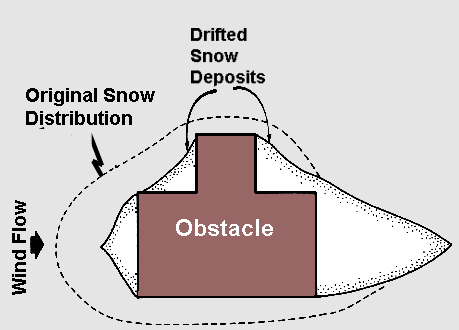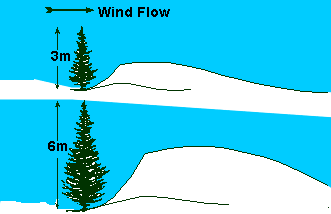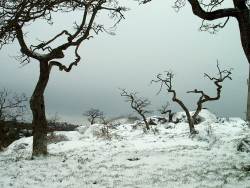 |
 |
| Home | Welcome | What's New | Site Map | Glossary | Weather Doctor Amazon Store | Book Store | Accolades | Email Us |
 | |||||||||||||
Weather Almanac for February 2004GETTING THE DRIFTThat the dry snow fell in copious quantity all through the night was bad enough. That it fell like the emptying of a million feather pillows into a hurricane just made matters worse. We could have coped, at least to some degree of sanity, with twenty centimetres making a uniform duvet over the community, but having it whipped into waist-level—and higher—drifts across traffic lanes and driveways elicited words of displeasure not suitable for repetition here.
Just before noon, the full fury of the storm was unleashed. As the cold front rushed quickly over us; the temperature plummeted, first ten, then twenty degrees below freezing. The wind shifted to gusty northerly gales in a heartbeat, whipped the newly fallen snow high into the air. Some of the airborne snow quickly rushed back down, only to be recaptured in the turbulent gusts and sent further on their way. Snowdrifts began to crest on the snowy sea, and from their crests, crazed ice crystals hissed as they ran across the snow surface like an army of beetles fleeing the light. Other snowflakes and ice crystals reached escape velocity, rising high into the sky on a journey to points unknown far from their launch point. The massive, migrating population reduced the visibility to mere metres. Only when the wicked wind paused to recharge, did we catch a glimpse of the buildings across the courtyard.
The blowing, and subsequent drifting, of snow can change a snowstorm or post-storm condition into a blizzard even if no new snow is falling from the clouds. By definition, a blizzard need only have winds exceeding a threshold speed (40 km/h in Canada; 35 mph in the US), reduced visibility (less than a kilometre in Canada; a quarter mile or less in the US) from either blowing or falling snow, and duration of three hours or more (depending on the Canadian province). The blowing of snow, like the blowing of sand, creates its first hazards in visibility reduction. But, to quote the old saying, "what goes up, must come down," and generally a good episode of blowing snow sculpts snow dunes worthy of any sandy beach or desert landscape. Heavy accumulations of snow can prove a major obstacle to living creatures including us humans, but rearrange it into drifts metres high and you have a nightmare in white fluff. The impacts of drifting snow are more than the piling up of backbreaking mounds to shovel, or obstructing roadways, or burying vehicles. Formed in an inopportune location around a building, a snowdrift can imprison occupants by blocking exits. The Physics of Blowing and Drifting SnowSnow becomes airborne and then forms drifts when wind catches falling snow or lifts loose snow crystals from the underlying surface. The process is in some ways analogous to blowing dust and sand (see Dust in the Wind) except that snow is much less dense and can change phases (melting, sublimating) under normal environmental conditions. Of course, falling snow may become windblown by even the lightest winds, and it thus can be deposited in common locations to form drifts. But for snow to be lifted from the surface and carried by the wind, a speed of 13 km/h (8 mph) or more is required. Once lofted, snow crystals will remain in suspension until the wind speed drops in general, or the crystals enter a region where surface features reduce the wind speed. The quantity of snow carried by the wind, and the distance it travels, depend not only on the wind speed and its level of gustiness (turbulence) but also on air temperature, the nature of the snow itself, and the fetch over which the wind is blowing. Light, dry snow, formed under cold air temperatures, is ideal for blowing and drifting while heavier, wet snow takes more wind force, and icy snow surfaces resist even the strongest winds. A gust may raise a small flurry of snow from a rooftop, but run a strong wind across a flat field, and the volume of raised snow can be prodigious, measured in tonnes rather than cups full. Once airborne, individual snow crystals dance and cavort with the wind as it sweeps across a landscape and among, beneath, over, around, and even through terrain features. On the smallest scale, called the microscale, the wind accelerates and decelerates in response to the presence of features as small as grass blades and as large as mountains and skyscrapers. For example, a relatively exposed hilltop bare of tree or bush, even one only 1.3 to 2 metres (4-6 ft) above the surrounding terrain, can be swept clean of snow, and in the absence of other obstacles that snow may be deposited on the lee (downwind) side of the hill or in some downwind depression in the surface. Then again, it may land in the next county.
On very flat terrain, such as a frozen lake surface or prairie, snow can blow for tens, even hundreds, of kilometres before being redeposited on the ground or amongst buildings or vegetation. In such terrain, drifts may form in shapes similar to the variety of sand dunes. For example, transverse dunes, large dune fields that consist of ridges of sand with a steep face on the downwind side forming where sand is abundant and wind flows are constant in direction, have a snow analogy, called sastrugi in the Arctic. In terrain where obstacles of many types, sizes and shapes are present, snowdrifts can form a very complex "dune" field. Obstacles that present a barrier to the unobstructed flow of wind will form a drift in the region of the turbulent flow when wind speeds drop, usually a distance behind the object. Such obstacles as hedges, trees, fences, buildings, and even snow piled by removal activities present unique variations in the wind flow pattern. Not only do they have regions where wind speed diminishes, but they often also have regions where wind speeds accelerate. Such acceleration zones are void of drifts and may have their snow scoured to the ground, becoming the source region for downwind drifts. The height and breadth of the obstacle will affect the nature of snowdrifting around it as will its porosity (the percentage and size of "holes" in the barrier). As a rule of thumb, drifts will extend downwind from an obstacle of moderate-height to six to nine times the height. Impacts of SnowdriftingAs I said earlier, snowdrifting can result in more than a nuisance to snow-removal efforts. Snowdrifting around buildings and other structures can cause safety hazards and even trap occupants within. Two examples of building hazards resulting from snowdrifting are the blocking of doors and exhaust ports and the buildup of snow on roofs.  The tool most used by researchers to study snow drifting is a water flume into which sand is dropped into the moving water, a technique pioneered by Professor Frank Theakston at the University of Guelph. (Clay or glass beads have been used in wind tunnels such as the Snow Drift Wind Tunnel at the USACE Engineer Research and Development Center.) When the sand is sifted over the water surface like falling snow, the water currents carry it in a manner that simulates snowfall and snowdrifting on a smaller scale. By placing a model of a building, a building complex, or section of roadway in the water flume, the researchers can simulate how snow will drift around the full-sized configuration under a specific wind direction. Usually several directions are tested that corresponded to climatological storm-wind or high-wind directions. When the waterflow is stopped, the height and locations of the sand piles are noted, and if the test shows a possible problem area, a remediation can be proposed and tested. This may involve the adding or subtracting of a building element, landscaping, a fence or other feature to the configuration. One of the first examples of this work I recall seeing demonstrated was for a university building where drifting snow blocked emergency exit doors (which had caused the client to seek their advice). By adding a small element to a building wall similar to a windbreak, the resulting drift was moved several metres out rather than forming against the exitway. By analyzing the simulation, architects were not only able to correct problems after the fact but also test remediation designs before construction. A pre-construction remedy may be as simple as a small change in landscaping or in the orientation of a building on the property. For example, placing the long axis of a building in the direction of the prevailing winter winds minimizes some problems arising from drifting compared to placing that axis perpendicular to the prevailing wind.  Simulated urban snowdrifting (University of Western Ontario). Similar expertise developed from engineering science as well as observational field experience has been used to prevent or reduce snowdrift formation over rural roads through the use of snow fencing. In such cases, the fencing is installed each autumn and removed in the spring. In other cases, landscaping, such as the planting of a row of low trees or bushes, can be used as a permanent "snow fence" with the same winter affect. The function of a snow fence is to cause wind-blown snow to settle before it reaches the site requiring protection. The fence must be erected perpendicular to the prevailing wind direction so that the snow deposits in front of and behind it. The height and placement of the fence are also important to assure drifts form in areas away from the road and not on it. The above style of snow fencing is termed collector fencing because its purpose is to collect the snow near the fence. Fencing may also be used to keep specific areas clear of snow by increasing the wind speed and thus blowing the snow elsewhere. Such fencing is called blower fencing and deflector fencing, depending on its configuration. Natural materials such as hedges—low coniferous trees and bushes—and earthen dams can also be used in the same manner as snow fencing. Even properly placed and sized snow dams can be employed to reduce adverse drifting potential. Hedging has the advantage of low maintenance but requires time to grow before becoming effective. Natural snow-control landscaping has been used by farmers for years, as farmers learned by experience how best to corral snow.  The continued blowing of snow in the wake of this recent storm has frustrated city road crews and residents alike. Even though the fall of snow had ceased hours ago, the rearranging of the fallen snow recovers roads, walks and driveways so recently cleaned. All of us are hoping for a little calm to settle the situation. Learn More About Snow From These Relevant Books
|
|||||||||||||
 |
To Purchase Notecard, |
Now Available! Order Today! | |
 |
 |
NEW! Now |
The BC Weather Book: |


